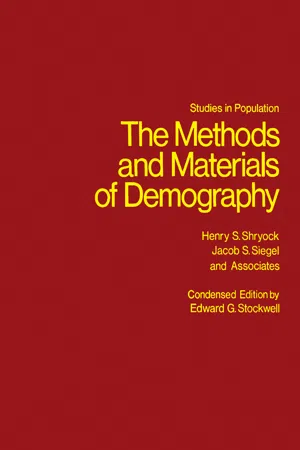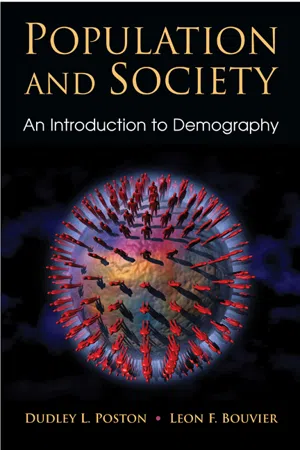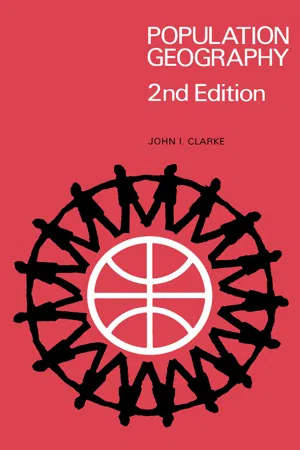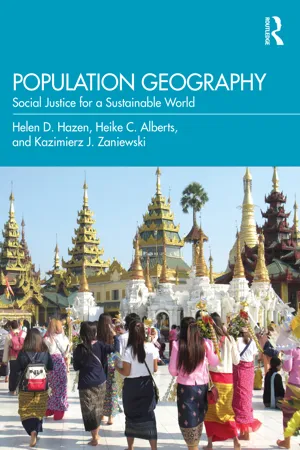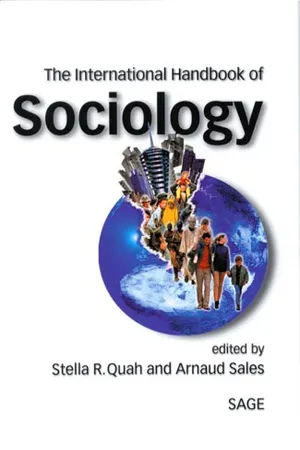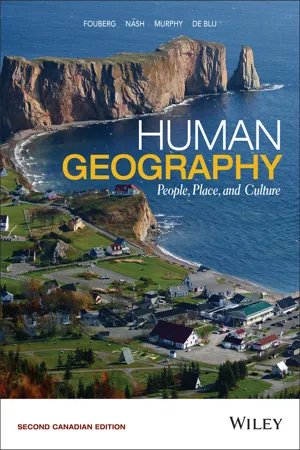Mathematics
Population Change
Population change refers to the variation in the size of a population over a specific period. It is often measured by the difference between the number of births and deaths, as well as migration. In mathematics, population change is a key concept in the study of statistics and demography, and it is often analyzed using mathematical models and formulas.
Written by Perlego with AI-assistance
Related key terms
1 of 5
8 Key excerpts on "Population Change"
- eBook - PDF
- Henry S. Shryock, Jacob S. Siegel(Authors)
- 2013(Publication Date)
- Academic Press(Publisher)
CHAPTER 13 Population Change DEFINITION AND TYPES Direction Change is measured by the difference between population sizes at different dates. Partly because of the prevailing modern trend of population in the countries of the world, people often speak loosely of population growth when actually either increase or decrease is possible. In census reports, increases are usually shown without a plus sign, but decreases are indi-cated by a minus sign. Absolute and Percentage Change The absolute amount of change is obtained by subtracting the population at the earlier date from that at the later date. The percent of change is obtained by dividing the absolute change by the population at the earlier date. Many census tables, particularly those on total population, include columns with the following type of arrangement of captions: Increase Number Percent Using the population at the earlier census as the base of the period of change is dictated partly by logic and partly by convenience. Analogy with the calculation of vital rates would suggest the use of the midperiod population, but that would have to be estimated. There are many other types of demo-graphic rates that are based on the population at the beginning of the period, e.g., survival rates and migration propensity rates. PITFALLS IN MEASUREMENT In measuring Population Change, one should be sure that the population of the area or group is comparable over the period in question. The area should be constant, the group should be defined on a consistent basis, and the accuracy of coverage or classification should not vary appreciably. And yet as a practical matter, adjustments are rarely practical; and, unless the modification is fairly extreme, the change is usually com-puted on the basis of the published figures. Knowledge of these differences is important for analysis, however; and it is often at that stage, rather than in the official report, that adjustments are attempted for the more serious cases. - eBook - PDF
Population and Society
An Introduction to Demography
- Dudley L. Poston, Jr., Leon F. Bouvier(Authors)
- 2010(Publication Date)
- Cambridge University Press(Publisher)
270 World Population Change over Time things, it will be precisely this society and this society alone which will carry this out without difficulty” (cited in Gimenez, 1971: 4). Strictly speaking, a population is a group or collection of items. But to a demographer, a population is a group or collection of people. Samuel H. Preston, Patrick Heuveline, and Michel Guillot (2001: 1) have distinguished between a specific population or group of actual people alive at a given period of time (e.g., the population of the United States as of April 1, 2000) and the population that persists over time even though its actual members may change (e.g., the population of China during the past 4,000 years). But as McNicoll has noted, the more common use of the term population by demographers and in modern English usage is with regard to a “well- defined set, with clear-cut membership criteria” (2003: 731), such as the population of the People’s Republic of China as identified and enumerated in its 2000 census. In a similar vein, Norman B. Ryder (1964: 448) considered a popula- tion to be an aggregate of individuals defined in spatial and temporal terms. It is not necessarily a group, which in sociological terms requires some form of interpersonal interaction and the development of a sense of community. The analysis of human populations is inherently dynamic because attention is focused on changes in the population over time. The population equation shown in the next section is an example. Ryder also stated that the population model is both microdynamic and macrodynamic in nature. This means that processes of change in fertility, mortality, and migration can be identified at both the individual and the aggregate levels. This distinction lies at the very heart of the population model because it introduces Alfred J. Lotka’s ([1934] 1998) important dis- tinction between the persistence of the individual and the persistence of the aggregate. - eBook - ePub
- Béla Tomka(Author)
- 2013(Publication Date)
- Routledge(Publisher)
2
POPULATION
Population events are of significance at a variety of scales both in the life of individuals and in the evolution of societies. Childbirth, migration and death constitute turning points in the human life-course often marked by ceremonies, such as christening and funerals, which carry diverse societal and cultural meanings. Population occurrences considered together also have a great impact on the trajectory of societies. Births and immigration increase the size of population, whereas deaths and migration decrease it. In addition, population events taken in the aggregate induce shifts between the groups constituting societies. Fertility and migration usually exhibit considerable differentials between social strata and between ethnic groups; even the risk of death varies with social classes. Thus, the results of demographic processes greatly contribute to social dynamics. In turn, demographic events are themselves affected by the intricate interplay of contextual factors. Although the demographic behaviour of families is apparently determined by individual preferences and choices, in reality, the range of options available for them is considerably influenced by economic, social, cultural and political circumstances. For instance, established patterns in family size are among the crucial determinants of fertility, and migration can be constrained by legal frameworks, whereas mortality is often closely related to the living standard.1The study of Population Change has an ancient history, however, and as a distinct field of research is usually traced back to the seventeenth century, when John Graunt and his followers developed the concept of life table, forecasting the longevity of members of a group based on the longevity of other members of the same group. The classical period of political economy in the eighteenth century and particularly the writings of Thomas Robert Malthus brought further advances in demography. He is well known for the thesis that population left unchecked would grow faster than the resources available for society. More importantly, the relationship between population characteristics, social change and economic conditions was considered in his works, and the path was set for further study of the relationship between demographic events in the nineteenth and twentieth century. Public and scholarly interest in population has alternated since then in Europe in terms of both intensity and focus. In the early decades of the twentieth century, for instance, the low fertility evident in many countries of Europe had a great impact on the development of population thought and discourse. At mid-century, in turn, rapid population growth in the less-developed world attracted the most attention from scholars and politicians.2 - eBook - PDF
Population Geography
Pergamon Oxford Geographies
- John I. Clarke, W. B. Fisher(Authors)
- 2013(Publication Date)
- Pergamon(Publisher)
C H A P T E R Χ POPULATION G R O W T H THE reason for calling this chapter Population Growth rather than Population Change is that at national level very few populations are declining. Most are growing so rapidly that world population growth is one of the major problems of the present. On the other hand, within developed countries there are usually many districts experiencing population decUne. Measures of Population Growth and Replacement Apart from the absolute increase or decrease per annum, one of the most common measures of growth is the annual rate of increase. The U.N. Demo-graphic Yearbooks use the foUowing formula: X 100 where PQ is the population at the beginning of the period. Pi is the population at the end of the period, and t is the number of years. The two main components may be census returns or population estimates, and so the rate is subjea to the general quaUfications for such data. It is a useful rate, and may be helpful in assessing the accuracy of vital and migration statistics. Natural increase is the positive difference between the numbers of births and deaths, and the natural increase rate is the difference between the crude birth and death rates; natural decrease and natural decrease rates are negative differences, but they are less common, except in rural areas of developed countries. A natural increase rate may also be calculated by subtracting deaths from births and dividing by the population total for a specific year. Despite its widespread use, this rate expresses population growth very imperfectly, as it ignores the ageing of each individual diuring the year and does not differentiate between the deaths of old and young persons. In other words, natural increase rates ignore age-composition, so a population with a high proportion in the reproductive age-groups might have a positive natmral increase rate and yet experience low fertiUty and lack of replacement. - eBook - ePub
Population Geography
Social Justice for a Sustainable World
- Helen D. Hazen, Heike C. Alberts, Kazimierz J. Zaniewski(Authors)
- 2023(Publication Date)
- Routledge(Publisher)
CHAPTER 4 Population growth and changeDOI: 10.4324/9781003143253-4After reading this chapter, a student should be able to:- describe major changes in population size over time;
- discuss some of the key factors driving rapid population growth using the example of India;
- explain major theories of population growth and change associated with Malthus, Marx, and the demographic transition model.
Population growth has been one of the enduring trends of human population dynamics for much of human history. Although populations have fluctuated over short timescales, particularly in early human eras, in more recent centuries the human story has been one of population growth, with global population hitting 8 billion in November 2022. The environmental implications of this are profound, as more and more of the Earth’s land surface and energy have been appropriated for human use. In recent decades this trend has begun to slow, however, as many human populations have begun to limit fertility, leading us to a potential turning point—will human population size finally stabilize and even decline in the coming decades?PART I: POPULATION GROWTH OVER TIME
A short history of population growth
Most of us have seen graphs alerting us to the dramatic growth in human population experienced over the past 200 years. Population growth was indeed dramatic from the late 1700s onwards, with an almost eight-fold increase in global population size between 1800 and 2020 (figure 4.1 , inset graph). Prior to the 1700s, the story of human population was still of overall growth but in much more gradual and variable terms (figure 4.1 - eBook - PDF
- Stella R Quah, Arnaud Sales, Stella R Quah, Arnaud Sales(Authors)
- 2000(Publication Date)
- SAGE Publications Ltd(Publisher)
International Handbook of Sociology 273 13 Conceptual and Methodological Advances and Challenges in Demography Dudley L. Poston, Jr. This chapter reviews the field of demography from 1990 to the present and identifies what are in my opinion some of its major conceptual and methodological advances and challenges. Demography may be defined as the scientific study of the size, composition, and spatial distribution of human populations; and the changes that occur in these phenomena through the processes of fertility, mortality and migration. The subject matter of demography is often divided into formal or mathematical demography and social demography or population studies (Hauser and Duncan, 1959). Formal demography may be distinguished from social demography by the substantive foci of the independent and dependent variables. Both model dependent variables that are demographic in nature, viz., they are concerned with one of the demographic processes of fertility, mortality or migration, or, less frequently, with one of the so-called demographic characteristics of age and sex. However, the independent variables of formal demography are also demographic, whereas those of social demography are nondemographic. For instance, a formal demographer might examine among populations the influence of age composition on the birth rate, or, alternately, the influence of the birth rate on age composition. In contrast, a social demographer might study the influence of a sociological independent variable, such as social class, on the death rate; or the effects of a social psychological variable, such as attitudes about motherhood, on desired and intended fertility (see Kammeyer and Ginn, 1986: chapter 1, for discussion and more examples). Social demography is necessarily broader in scope and orientation than formal demography. - eBook - PDF
Human Geography
People, Place, and Culture
- Erin H. Fouberg, Alexander B. Nash, Alexander B. Murphy, Harm J. de Blij(Authors)
- 2015(Publication Date)
- Wiley(Publisher)
Therefore, we usually begin by considering Population Change within a defined terri- tory or unit of a country or other administrative unit, such as a province or city. One basic indicator of Population Change is the rate of natural increase (RNI) in a country’s population. The RNI is calculated by subtracting the deaths from births for the total population over a particular period of time, usually one year. For example, Canada’s RNI in 2011/2012 was 0.4 percent, calculated by subtracting the crude death rate (0.7 percent) from the crude birth rate (1.1 percent). This is a relatively simple statistic to calculate and compre- hend; however, calculating the natural increase misses two other key components in a country’s population: immigration, which along with births adds to the total population; and emigration Rate of natural increase (RNI) An indicator of Population Change, calculated by subtracting the crude death rate from the crude birth rate. 102 CHAPTER 4 Population FIGURE 4.16 World Population Growth, 2012. Annual natural rate of population increase by country. Population growth rates in Subsaharan Africa remain relatively high, and population growth rates in Europe and Russia remain relatively low. Data from: Population Reference Bureau, 2012. (outmigration), which along with deaths subtracts from the total population. Using these four components, we can calcu- late demographic change within a territory. Population Change AT THE WORLD SCALE World population growth is mapped in Figure 4.16. Most of the world’s population growth is expected to be in Africa, Asia, and Central and South America. This measure of population growth does not, however, take into account emigration and immigration, which we will discuss in Chapter 5. Other maps and tables of population growth may take into account emigra- tion and immigration. Statistics for each population trait can be calculated globally, by region, by country, or even for smaller locales. - eBook - PDF
Handbook of Social Problems
A Comparative International Perspective
- George Ritzer(Author)
- 2003(Publication Date)
- SAGE Publications, Inc(Publisher)
However, the specific ways in which Population Changes affect societies vary across countries, as do actions required to deal with population growth. Societies with growing economies such as the East Asian countries are better able to accommodate pop-ulation growth than sub-Saharan countries with low rates of economic growth. Similarly, Costa Rica has tried to address the problem of population growth by investing in education and child health, Indonesia has set up a strong family planning program, and China and Singapore have emphasized strong sanc-tions against people who have too many children. While poor countries are trying to deal with prob-lems associated with growing populations, industrial societies are trying to deal with strains of declining and aging populations. Thus, any examination of social problems associ-ated with population growth must start with a better understanding of different dimensions of Population Change and locate these trends within a broader socioeconomic landscape. This chapter examines the trends in three major factors that affect the size of national populations: mortality, fertility, and migra-tion. By focusing on changes in these determinants of the ultimate population size in historical and cross-cultural contexts, the chapter seeks to under-stand the problems associated with changing fertility, mortality, and migration patterns and to trace public policy options for dealing with these problems. MORTALITY DECLINE AND POPULATION GROWTH Life expectancy at birth 2 in the Roman era is esti-mated to be around 22 years, rising to around 35 in the Middle Ages for Western Europe (Petersen 1975). Since the industrial revolution, however, life expectancy has been steadily improving, with a rapid improvement in the twentieth century.
Index pages curate the most relevant extracts from our library of academic textbooks. They’ve been created using an in-house natural language model (NLM), each adding context and meaning to key research topics.
